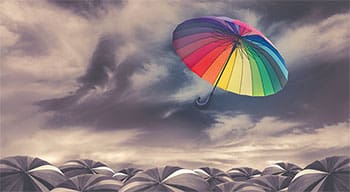Tap into creativity to reduce stress and increase positive emotions.
Takeaways:
- Artistic expression is an enjoyable component of an overall wellness plan that enhances mood and emotion.
- Creative activities can decrease depressive symptoms, reduce stress, and in some cases improve immune system functioning and cognitive strength.
- Engage in artistic pursuits to fully embrace your wellness plan.
By Laura D. Newpoff; Bernadette Mazurek Melnyk, PhD, RN, APRN-CNP, FAANP, FNAP, FAAN; Susan Neale, MFA
This is the eighth installment in a series of articles on wellness. You can read the earlier articles at myamericannurse.com/category/wellness101/.
Expressing yourself through the arts can be one of the more enjoyable components of an overall wellness plan. According to the American Public Health Association, engagement with artistic activities, either as an observer or a creator, can enhance a person’s mood, emotions, and other positive psychological states and have a salient impact on important health parameters.
 Creativity has long been thought of as a key piece of the wellness puzzle. A review of more than 100 studies of the benefits of the arts (music, visual arts, dance, and writing) found that creative expression has a powerful impact on health and well being among various patient populations. Most of the studies agree that engagement in the arts decreases depressive symptoms, increases positive emotions, reduces stress, and, in some cases, improves immune system functioning.
Creativity has long been thought of as a key piece of the wellness puzzle. A review of more than 100 studies of the benefits of the arts (music, visual arts, dance, and writing) found that creative expression has a powerful impact on health and well being among various patient populations. Most of the studies agree that engagement in the arts decreases depressive symptoms, increases positive emotions, reduces stress, and, in some cases, improves immune system functioning.
Other studies found that creative works and exposure to the arts can impact conditions like Parkinson’s disease and some forms of dementia and cancer. Creative wellness is good for your intellectual wellness, too. A study by the Mayo Clinic found that people who engage in activities like painting, drawing, sculpting, and crafts (woodworking, pottery, ceramics, quilting) in middle age and older may delay cognitive decline. When studying people in their mid- to late 80s, researchers have found that the behavior with the greatest protective effect against cognitive decline was artistic activity.
We’re all creative
Many people miss out on the joy of creative expression because they fear they’re not “talented” or that they’re not good at a particular activity. But if you can let go of the need to be good at something, you can have a lot of fun. If you want to play a new sport, you probably have to learn from the beginning and practice for a long time, and the same is true for most artistic endeavors. So don’t be disappointed if you can’t pick up a flute and play it right away, or dance a complicated routine in your first class. Remind yourself that it’s okay to be a beginner. Pick an area of creative expression that looks fun to you, and try to just enjoy it without judging yourself.
The Artist’s Wayby Julia Cameron is an international bestseller that has helped millions of people overcome their creative fears. Here are some insights from the author:
- Give yourself permission to be a beginner.
- Learning to let yourself create is like learning to walk. The artist child must begin by crawling. Baby steps will follow…it is necessary to go gently and slowly.
- We are far more colorful, far more creative, and far more charismatic than we know.
- With art, we [are]…more truly ourselves, and those selves are colorful and beautiful.
Art therapy “is rich with opportunities for research that can enhance and validate what is already common knowledge to most art therapists and their clients: that art is life enhancing,” according to art therapy expert Dr. Cathy Malchiodi. Stress-management expert Elizabeth Scott assures us that “Those who are not artistically inclined can still gain quite a bit from artistic creation…
Studies that examine the effects of art on stress and mood don’t analyze the talent of the subjects or the quality of their creations, just the effects on how they feel afterward, and these effects are highly positive.”
How to be creatively well
Art, music, dance, writing, and drama are considered the traditional healing arts, but you can seek out dozens of creative pursuits as part of a wellness plan to help you lower stress, cope with a loss, form new connections, and simply be happier. Here are some things you can do to weave creative wellness principles into even the busiest schedule:
Join an art or pottery class. While you learn something new and enjoy artistic activity, you also may benefit from social interaction with others and the chance to make new friends. Many venues stress that no talent or experience is necessary to participate.
Try dance. Dancing is known as a stress reliever that releases endorphins, and it can be a good workout, too. If you’re nervous about trying to pirouette or bust a move in front of a group of strangers, buy an instructional video or find one online and give it a whirl at home. Mix dancing in with your workout routine to fight off monotony or join a class with other beginners to form connections.
Use the magic of music. Make releasing more of those feel-good endorphins a regular practice by belting out some of your favorite tunes, whether you’re in the car, the shower, or on a break at work. It’s been reported that singing can help ease muscle tension and decrease stress hormones. Listening to your favorite music also can help you relax and reduce stress.
Journal and doodle. Instead of pouring a glass of wine or turning on the TV to wind down after a stressful day at work, pull out a blank journal and chronicle your day with doodles. You can experiment with different shapes and colors and even download doodling apps—such as the free Doodle Buddy and You Doodle—to help spark an endless number of creative ideas.
Express yourself through poetry and writing. Expressing your thoughts in new ways can be a cathartic exercise. Try poetry to communicate your feelings, especially during times when you need closure or are trying to understand an insecurity. Writing, in general, is one of the great healing arts. A simple daily diary can help you release feelings onto a page instead of keeping them bottled up inside.
Try drama. Acting can be a great way to explore your creative side. If you’ve never done it before, try a small role or nonspeaking part, or volunteer at your community theater and ask what you can do to help put on a play. Don’t have time for a major production? Borrow a book of plays from the library and get some friends together to take parts and read one aloud.
Conceive of a photography project. Photography used to be an expensive hobby, but now most smartphones come equipped with high-quality cameras. Your photo project can revolve around a theme, such as covered bridges or old barns. The exercise will allow you to practice mindfulness—you’ll pay more at- tention to every bridge and barn you see—and have an artistic product to show off at the end.
Take in the ballet or visit an art museum. We get so busy in our daily routines that we often don’t notice when a world-class art exhibit arrives at the local museum or a rare dance performance comes to town. Make enjoying arts and cultural venues a way to relax, broaden your horizons, and get out of a rut. Buy some tickets far in advance so you’ll have something to look forward to. To increase your artistic awareness, learn more about the performance ahead of time.
Have fun cooking. Join a cooking class or buy a cookbook focused on foods you’re not used to preparing and get creative in the kitchen. Or, instead of a book club, start a cooking club with your friends and come up with a rotating menu of dishes from different ethnic cuisines to experiment with at each other’s homes. Not only will the club foster fun and social interaction, but it also will allow you to experience something completely new and have something to look forward to.
Endless possibilities
There are plenty of other creative efforts you can pursue as part of your wellness strategy. You can get creative while gardening, writing a presentation or toast, helping a friend redecorate her home—the possibilities are endless. Some of the world’s greatest artists had no formal road map for their paintings, poems, or prose, and you don’t need one either.
Laura D. Newpoff is a writer and journalist in Columbus, Ohio. She writes for The Ohio State University College of Nursing’s alumni magazine, Transformations in Nursing and Health. The other authors work at The Ohio State University in Columbus. Bernadette Mazurek Melnyk is the vice president for health promotion, university chief wellness officer, dean and professor in the college of nursing, professor of pediatrics and psychiatry in the college of medicine, and executive director of the Helene Fuld Health Trust National Institute for Evidence-based Practice in Nursing and Healthcare. Susan Neale is senior writer/editor of marketing and communications in The Ohio State University College of Nursing.
Selected references
Jacobs T. Making art tied to fewer cognitive problems in old age. Pacific Standard. April 8, 2015.
Malchiodi C. Art making and stress reduction. Psychology Today. June 28, 2016.
Malchiodi C. Creativity as a wellness practice. Psychology Today. December 31, 2015.
Scott E. Art activities for stress relief. January 31, 2018.
Stuckey HL, Nobel J. The connection between art, healing, and public health: A review of current literature. Am J Public Health. 2010;100(2):254-63.
11-13 Creative Wellness



















1 Comment.
I am writing in response to the article titled “Creative wellness: A missing link
in boosting well-being”, published in Volume 13, 8th edition of American Nurse Today.
I have experienced firsthand the affect creativity has on healing and would like to share my thoughts and provide evidence that creative
arts has implications for increasing well being.
Prior to attending nursing school I earned a bachelors and masters degree in fine art. For several years, I co-created and ran a mobile
art gallery in Philadelphia that crafted experiences which encouraged gallery go-ers to interact with artworks and artists. One of the goals was to make fine art more accessible and less intimidating. I also worked as a studio artist in the art therapy department
of an inpatient eating disorder clinic for seven years. While the implications of creative work I witnessed there was specifically related to eating disorder recover, I believe implementing art making into other clinical settings can be valuable. A recent
study on the impact of a visual arts program on people living with dementia by Gill Windle, Karlijn J. Joling, Teri Howson-Griffiths, Bob Woods, Catrin Hedd Jones, Peter M. van de Ven, Andrew Newman, Clive Parkinson, published in
International Psychogeriatrics
in November 2017, encouraged the use of art activities by dementia care providers to increase well being. This is exciting to me and I hope to see more research in this area.
I am sharing my thoughts because I am delighted to read articles that encourage all people to explore their creativity. I hope to one day
be able to integrate my passion for creative arts with my nursing work.
Thank you for taking the time to read my response.
Sincerely,
Lauren Brown RN, RN-BSN-Student